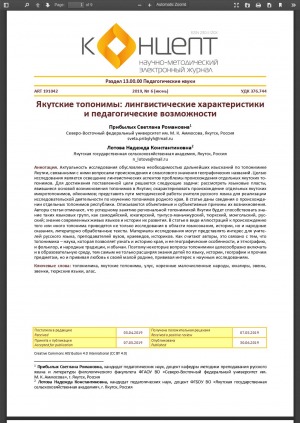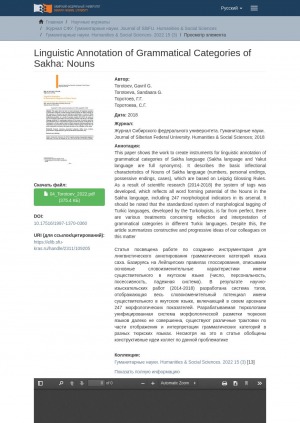Тематические подборки
Издания подборки 1 - 3 из 3
Год выпуска: 2019
Актуальность исследования обусловлена необходимостью дальнейших изысканий по топонимике Якутии, связанными с ними вопросами происхождения и смыслового значения географических названий. Целью исследования является освещение лингвистических аспектов проблемы происхождения отдельных якутских топонимов. Для достижения поставленной цели решаются следующие задачи: рассмотреть языковые пласты, явившиеся основой возникновения топонимов в Якутии; охарактеризовать происхождение отдельных якутских микротопонимов, ойконимов; представить пути методической работы учителя русского языка для реализации исследовательской деятельности по изучению топонимов родного края. В статье даны сведения о происхождении отдельных топонимов республики. Описываются объективные и субъективные причины их возникновения. Авторы статьи отмечают, что успешному занятию региональной топонимикой Якутии будет способствовать знание таких языковых групп, как самодийский, юкагирский, тунгусо-маньчжурский, тюркский, монгольский, русский; знание современных живых языков и истории их развития. В статье в виде иллюстраций к происхождению того или иного топонима приводятся не только исследования в области языкознания, истории, но и народные сказания, литературно обработанные тексты. Материалы исследования могут представлять интерес для учителей русского языка, преподавателей вузов, краеведов, историков. Как считают авторы, это связано с тем, что топонимика - наука, которая позволяет узнать и историю края, и ее географические особенности, и этнографию, и фольклор, и народные традиции, и обычаи. Поэтому некоторые вопросы топонимики целесообразно включать и в образовательную среду, тем самым не только расширяя знания детей по языку, истории, географии и прочим предметам, но и прививая любовь к своей малой родине, прививая интерес к научным исследованиям
The relevance of the study is due to the need for further research on the toponymy of Yakutia, related issues of the origin and semantic meaning of geographical names. The purpose of the study is to highlight the linguistic aspects of the problem of individual Yakut toponyms origin. To achieve this goal, the following tasks are solved: to study the language strata, which were the basis for the emergence of toponyms in Yakutia; to characterize the origin of individual Yakut microtoponyms, oeconyms; to present the ways of the methodical work of the Russian language teacher for the implementation of research work on the study of the native land toponyms. The article provides information about the origin of individual toponyms in the republic. The objective and subjective reasons for their origin are described. The authors of the article note that knowing such language groups as Samoyed, Yukaghir, Manchu-Tungus, Turkic, Mongolian, Russian will contribute to the successful learning of regional toponymy of Yakutia, as well as knowledge of modern living languages and the history of their development. The article, in the form of illustrations to the origin of a toponym, cites not only the works in the field of linguistics and history, but also folk tales and literary texts. Research materials may be interesting to teachers of Russian, university academic staff, regional ethnographers, and historians. This is due to the fact that, according to the authors, toponymy is a science that allows us to learn the history of the region, its geographical features, ethnography, folklore, folk traditions and customs. Therefore, it is advisable to include some toponymic questions in the educational environment, thereby expanding not only children's knowledge of language, history, geography, etc., but also infusing children with love for their homeland, cultivating an interest in scientific research
The relevance of the study is due to the need for further research on the toponymy of Yakutia, related issues of the origin and semantic meaning of geographical names. The purpose of the study is to highlight the linguistic aspects of the problem of individual Yakut toponyms origin. To achieve this goal, the following tasks are solved: to study the language strata, which were the basis for the emergence of toponyms in Yakutia; to characterize the origin of individual Yakut microtoponyms, oeconyms; to present the ways of the methodical work of the Russian language teacher for the implementation of research work on the study of the native land toponyms. The article provides information about the origin of individual toponyms in the republic. The objective and subjective reasons for their origin are described. The authors of the article note that knowing such language groups as Samoyed, Yukaghir, Manchu-Tungus, Turkic, Mongolian, Russian will contribute to the successful learning of regional toponymy of Yakutia, as well as knowledge of modern living languages and the history of their development. The article, in the form of illustrations to the origin of a toponym, cites not only the works in the field of linguistics and history, but also folk tales and literary texts. Research materials may be interesting to teachers of Russian, university academic staff, regional ethnographers, and historians. This is due to the fact that, according to the authors, toponymy is a science that allows us to learn the history of the region, its geographical features, ethnography, folklore, folk traditions and customs. Therefore, it is advisable to include some toponymic questions in the educational environment, thereby expanding not only children's knowledge of language, history, geography, etc., but also infusing children with love for their homeland, cultivating an interest in scientific research
Авторы:
Torotoev Gavril G. ,
Torotoeva Sandaara G.
Год выпуска: 2022
This paper shows the work to create instruments for linguistic annotation of grammatical categories of Sakha language (Sakha language and Yakut language are full synonyms). It describes the basic inflectional characteristics of Nouns of Sakha language (numbers, personal endings, possessive endings, cases), which are based on Leipzig Glossing Rules. As a result of scientific research (2014-2018) the system of tags was developed, which reflects all word forming potential of the Nouns in the Sakha language, including 247 morphological indicators in its arsenal. It should be noted that the standardized system of morphological tagging of Turkic languages, developed by the Turkologists, is far from perfect, there are various treatments concerning reflection and interpretation of grammatical categories in different Turkic languages. Despite this, the article summarizes constructive and progressive ideas of our colleagues on this matter
Статья посвящена работе по созданию инструментария для лингвистического аннотирования грамматических категорий языка саха. Базируясь на Лейпцигских правилах глоссирования, описываем основные словоизменительные характеристики имени существительного в якутском языке (число, персональность, посессивность, падежная система). В результате научно-изыскательских работ (2014-2018) создана система тэгов, отображающая весь словоизменительный потенциал имени существительного в якутском языке, включающий в своем арсенале 247 морфологических показателей. Разрабатываемая тюркологами унифицированная система морфологической разметки тюркских языков далеко не совершенна, существуют различные трактовки по части отображения и интерпретации грамматических категорий в разных тюркских языках. Несмотря на это, в статье обобщены конструктивные идеи коллег по данной проблематике
Статья посвящена работе по созданию инструментария для лингвистического аннотирования грамматических категорий языка саха. Базируясь на Лейпцигских правилах глоссирования, описываем основные словоизменительные характеристики имени существительного в якутском языке (число, персональность, посессивность, падежная система). В результате научно-изыскательских работ (2014-2018) создана система тэгов, отображающая весь словоизменительный потенциал имени существительного в якутском языке, включающий в своем арсенале 247 морфологических показателей. Разрабатываемая тюркологами унифицированная система морфологической разметки тюркских языков далеко не совершенна, существуют различные трактовки по части отображения и интерпретации грамматических категорий в разных тюркских языках. Несмотря на это, в статье обобщены конструктивные идеи коллег по данной проблематике


